Generality
The obstructed coronaries are the result of a process of partial or total occlusion of the arteries, the aforementioned coronary arteries, which supply the myocardium with oxygenated blood.

In most cases, the phenomenon of obstructed coronary arteries is due to atherosclerosis and to the thrombo-embolic effects that the latter can trigger; more rarely, it follows a coronary vasculitis or a coronary spasm.
Associated with symptoms such as chest pain, dyspnea, profuse sweating, vertigo, etc., the presence of obstructed coronary arteries is always a cause of great concern, as it is the basis for conditions such as angina pectoris and myocardial infarction.
The treatment of the problem of obstructed coronaries includes the adoption of a healthy lifestyle and, depending on the degree of occlusion, a pharmacological or surgical therapy.
Short review of what the coronaries are
Coronaries are the arteries that supply the myocardium, or muscle of the heart, with oxygenated blood. In other words, the coronary arteries are the arterial blood vessels that keep the heart alive, as they are the suppliers of oxygen and essential nutrients for survival.
The coronaries originate in the earliest stretches of the ascending aorta ; in fact, they represent the first branches of the aorta .
What are Ostruite Coronaries?
Coronary obstructed is the expression of jargon indicating the process of partial or total occlusion of the coronary arteries, a process which, in medicine, is called coronary artery disease or coronary artery disease .
The presence of obstructed coronaries is an obstacle to the inflow of oxygenated blood in the myocardium and this lays the foundation for a very dangerous medical condition, known as myocardial ischemia or ischemic heart disease, in which the blood supply to the heart muscle it is less than the real needs.
The consequences of obstructed coronaries and myocardial ischemia
The myocardial ischemia resulting from the presence of obstructed coronary arteries may be transient (therefore, after a certain period of time, the blood directed to the myocardium resume circulation) or permanent (that is, there is no possibility of a restoration of blood circulation in the center occlusion).
The first circumstance is an example of angina pectoris, while the second situation is an example of myocardial infarction (or heart attack ).
As can be guessed, between angina pectoris and myocardial infarction, the most serious consequence of obstructed coronaries is the heart attack.
Epidemiology
The obstructed coronaries are a widespread problem, so much so that the ischemic heart disease closely connected to them represents the main cause of death in the countries of the so-called Western world.
Until a few decades ago, the presence of obstructed coronary arteries afflicted men more frequently than women; today, on the other hand, the gap between male and female patients has narrowed considerably, mainly due to an increase in the number of women.
Did you know that ...
In 2015, myocardial ischemia caused the death of 8.8 million people worldwide (as many as 15.5% of world deaths!), Ranking first among the reasons for death.
Causes
The presence of obstructed coronaries recognizes atherosclerosis and its effects at the vascular level ( thrombo-embolism ) and, as less common causes, coronary vasculitis and coronary spasm episodes.
What is atherosclerosis and how is it responsible for obstructed coronary arteries?
Atherosclerosis is the process of hardening and thickening of the medium and large caliber arteries, which over time creates the formation of atheromas on the wall of the arterial vessels just mentioned.
Also known as atherosclerotic plaque, an atheroma is an aggregate of lipid material (especially cholesterol ), protein and fibrous, which, in addition to narrowing the vessel lumen during formation, can also suffer injury and / or fragmentation.

Any lesions give rise to a coagulation process which, by drawing in platelets in place, has the unintended effect of expanding the atheroma itself ( thrombosis ), thus worsening the extent of the vasal narrowing; from the event of fragmentation, on the other hand, the formation of one or more emboli derives, that is, mobile bodies which, circulating freely in the blood, can lead to the complete occlusion of a blood vessel of equal size, even at a considerable distance from the place of origin.
When it is related to atherosclerosis, therefore, the phenomenon of obstructed coronary artery may depend on an atheroma within the same coronary arteries, which, following a lesion, called up platelets, grew further and caused occlusion, or from a fragment circulating in the blood of an atheroma located in a vessel other than coronaries.
Did you know that ...
When the obstructed coronary arteries are the result of an atheroma located in the coronaries themselves, the doctors identify the phenomenon in question with the term " coronary thrombosis ".
WHAT ARE THE CAUSES OF ATEROSCLEROSIS?
The conditions of atherosclerosis are caused by various conditions, including: hypertension, hypercholesterolemia, high triglycerides, advanced age, cigarette smoking and smoking in general, diabetes mellitus, obesity and some inflammatory diseases such as systemic lupus erythematosus.
Coronary vasculitis
In medicine, the word "vasculitis" indicates inflammation of the vascular walls; consequently, with coronary vasculitis, doctors understand the inflammation of the coronary artery walls.
Currently, the precise cause of coronary vasculitis episodes is unclear; it is a fact, however, that there is a correlation between the inflammation of the vascular wall and:
- Infections (eg: hepatitis B and hepatitis C);
- Autoimmune diseases (eg: rheumatoid arthritis, juvenile dermatomyositis and scleroderma);
- Allergic reactions to chemical solvents (eg: pesticides) or drugs (eg NSAIDs, sulfonamides and quinolones);
- Tumors to blood cells (eg, leukemia).
Vascular spasm in the coronary arteries
Coronary spasm is the sudden narrowing of a coronary artery due to the sudden and sudden contraction of the muscular component of a portion of the vessel wall.
Coronary spasms can be triggered / promoted by various factors, including:
- Intake of drugs such as cocaine, amphetamines and methamphetamine;
- Excessive exposure to cold;
- Strong emotional stresses;
- Tobacco smoke.
Symptoms and Complications
The typical symptoms and signs associated with the phenomenon of obstructed coronaries consist of:
- Chest pain or chest pressure;
- Pain that, from the chest, can radiate to the back, arm, shoulder, neck, jaw and / or stomach;
- Dyspnoea, ie breathlessness;

- Nausea with or without vomiting;
- Limitation of physical abilities. For example, the patient feels tired after any effort, even if minimal;
- Profuse sweating;
- Dizziness;
- Sense of anxiety.
Of these manifestations just listed, the most characteristic of obstructed coronaries is undoubtedly the pain / sense of pressure in the chest.
Why are clogged coronaries causing symptoms?
The symptoms of obstructed coronary arteries are the manifestation of the greater fatigue that the myocardium finds in pumping the blood in the circulation, when it receives a quantity of oxygenated blood inferior to the needs.
Like any other tissue in the human body, in fact, the heart muscle lives and works best only when the supply of oxygen (guaranteed by the blood) is adequate to the demands.
Complications
The phenomenon of obstructed coronaries leads to complications, when the vascular occlusion is permanent and the myocardium, due to a prolonged lack of oxygenated blood, undergoes necrosis, that is, death.
The death of the myocardium is an irreversible event and seriously compromises the functions of the heart, so as to be in many cases fatal for the individual concerned.
Specifically, serious cardiac arrhythmias (eg, ventricular fibrillation) and heart failure are among the complications attributable to the presence of obstructed coronaries.
Important : myocardial death due to permanent coronary obstruction coincides with myocardial infarction, ie the most severe of the two variants of ischemic heart disease mentioned in the initial passages of this article.
When should I go to the doctor?
Especially in a subject at risk of obstructed coronary arteries, it is always a valid reason to go to a doctor, or go to the nearest hospital, the apparently unjustified appearance of chest pain, combined with other disorders such as, for example, dyspnea, nausea, profuse sweating, anxiety and dizziness.
Diagnosis
Given the danger of the phenomenon of obstructed coronary arteries, its diagnosis must take place very quickly, otherwise the patient could develop fatal complications.
In general, in the list of investigations useful for identifying an occlusion of the coronaries, there are: the patient's account of the symptoms, the physical examination, the anamnesis, the echocardiogram, the electrocardiogram, the exercise test, blood tests, coronary angioTAC and coronary angiography .
Tale of symptoms, physical examination and medical history
- The patient's account of symptoms provides very useful information for diagnostic purposes; unfortunately, however, in the most serious situations, ie those in which the patient is unable to express himself due to a strong state of suffering, it is not a viable road;
- The physical examination and the anamnesis serve to further clarify the symptomatological picture and to identify the possible causal factors of the condition in progress.
Echocardiogram
The echocardiogram is the ultrasound of the heart ; it has various functions, including showing myocardial alterations due to the occurrence of coronary occlusion.
Electrocardiogram
The electrocardiogram evaluates the heart rate, ie the rhythm at which the heart beats.
An abnormality in the heart rate could be the signal of the reduced blood supply to the myocardium, which can be observed in the presence of severe coronary obstruction.
Stress test
The exercise test is used by the doctor to assess the effects of physical activity on the patient.
Blood analysis
Blood tests are used to quantify substances, such as creatine kinase or troponin (cardiac biomarker), whose levels tend to increase when damage occurs to the myocardium.
Coronary angioTAC
The coronary angioTAC is a radiological examination that allows the study of blood circulation in the coronaries.
In a context of obstructed coronaries, it is a source of information on the degree of vascular occlusion.

coronary angiography
Coronary angiography is a radiological examination that allows specific analysis of blood flow within the coronary arteries and pinpoints the location and severity of any occlusion.
In a context of obstructed coronaries, coronary angiography is the quintessential diagnostic confirmation test.
Therapy
The treatment of the obstructed coronary phenomenon includes an adjustment (obviously for the better) of the lifestyle and, depending on the severity of the coronary occlusion and of the symptoms, a drug therapy or a surgical therapy .
In general, the use of drugs is indicated in milder cases, while surgery in cases of greater severity.
Therapeutic goals
Before analyzing in detail the useful therapies in the presence of obstructed coronaries, it is important to point out the objectives of the treatment of a coronary occlusion:
- Lower the risk of coronary thrombosis, that is, reduce the possibility that an obstructive thrombus develops in a coronary artery;
- Prevent the most serious complications of ischemic heart disease;
- Counteract all conditions that could favor atherosclerosis (main cause of obstructed coronary arteries);
- Relieve symptoms;
- Eliminate coronary occlusion in order to restore myocardial blood supply.
Lifestyle changes
The lifestyle indicated to those suffering from obstructed coronary arteries includes: the adoption of a healthy and balanced diet, the abolition of smoking and any type of narcotic drug, a minimum consumption of alcohol, the achievement and maintenance of a state of normal weight, the control of blood pressure and cholesterol and, finally, the regular practice of a correct and measured physical activity.
Pharmacological therapy
Among the drugs used in the presence of obstructed coronaries, include:
- Anticoagulants (eg: heparin) and antiplatelet agents (eg: aspirin). They are beneficial because they improve the symptoms, reduce the size of any atheromas present, dissolve any abnormal blood clots and prevent the formation of new atheromas.
- Nitroglycerin . It is a drug with dilator effects against coronary arteries, but it is effective only in the middle of an episode of angina pectoris or infarction.
- Beta-blockers, ACE inhibitors and angiotensin II receptor antagonists . They are useful in the presence of obstructed coronary arteries associated with hypertension, as their intake induces a reduction in blood pressure.
- Statins . They are beneficial in the presence of obstructed coronary arteries associated with hypercholesterolemia, as their intake produces a reduction in cholesterol levels.
Surgical therapy
Angioplasty with stenting and coronary bypass operation are among the surgical treatments designed to counteract the phenomenon of blocked coronary arteries .
Did you know that ...
In some particular cases of obstructed coronary arteries, doctors believe it is essential to use both drugs and surgery.
ANGIOPLASTIC WITH STENTING
Angioplasty is the medical procedure that allows you to eliminate or, at least, reduce the narrowing or narrowing of a blood vessel, by using a particular catheter.
Stenting, on the other hand, consists of placing a metal prosthesis ( stent ) inside a blood vessel - previously occluded and reopened by angioplasty - in order to keep it patent over time and avoid second occlusions.
As it can be guessed, in a context of obstructed coronaries, angioplasty with stenting has as its object the coronary artery or the coronary victims of occlusion (coronary angioplasty with stenting ).

BYPASS CORONARICO
Coronary bypass surgery consists of creating a pathway for the passage of alternative blood to the occluded one, by inserting a new coronary vessel.
In other words, during a coronary bypass operation, the operating physician inserts a new coronary artery, the purpose of which is to replace, in functions, the obstructed original coronary artery.
Coronary bypass is a somewhat delicate surgical procedure.
Prevention
To prevent the phenomenon of obstructed coronary arteries, it is essential: to eat in a healthy and balanced way, to practice regular physical activity, not to smoke, not to take drugs, to maintain blood pressure, blood cholesterol and blood triglycerides, and, finally, to control the body weight in order to avoid overweight or obesity.
Prognosis
The phenomenon of obstructed coronary arteries is the signal of a sick heart, which at any moment can develop fatal consequences for the victim.
Statistics in hand, the prognosis in the case of obstructed coronary arteries is all the more ominous, the more serious is the degree of coronary occlusion.



